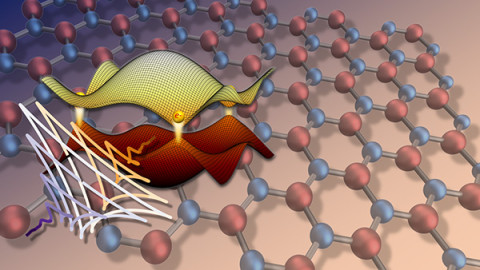ICMM researchers create ultrafast light techniques to modify crystalline materials, pioneering new electronics

Researchers at the Material Science Institute of Madrid (ICMM-CSIC) led two international studies published in Nature at the same time where they demonstrated a new theory that uses intense light pulses to modify crystalline materials. These works open the door to unprecedented control of the movements of electrons inside, enabling the use of new quantum degrees of freedom at ultrafast scales and, therefore, increasing the speed and capacity of information processing.
Crystalline materials are characterized by having an ordered structure and symmetry. These symmetries are closely related to the electronic properties of the material, so modifying them allows us to change or obtain new properties.
In this research, just published, ICMM-CSIC researchers Álvaro Jiménez and Rui Silva have developed a new method to manipulate the symmetry of those materials in an ultrafast way. “We propose to work with an optical field with the same symmetry as the structure of our material, to control the global symmetry properties of the system. In this way, the material's electronic properties can be changed in a few femtoseconds (equivalent to one quadrillionth of a second)," explains Jiménez Galán, one of the paper's lead authors. "By having the same symmetry as the material, simply by rotating the light pulse, we can change its electronic properties," adds Rui Silva, also one of the lead authors. These two scientists proposed this theory a few years ago and now, in collaboration with Stanford University, it has been experimentally demonstrated.
A powerful light pulse has been created that moves at two different frequencies and rotates in opposite directions, creating a clover-shaped light pulse. "The pulse can rotate on femtosecond scales," indicates Jiménez Galán, adding that these scales "are relevant because they are associated with coherent electronic motion. In this way, modifications in the material's properties preserve all quantum properties, which is essential, for example, for quantum computing," the researcher emphasizes.
This work is fundamental, among other fields, for valleytronics, which deals with electrons moving through the valleys formed in the crystal's band structure. Specifically, Stanford researchers have achieved "unprecedented control over the magnitude, location, and curvature" of these valleys by using this technique on monolayer hexagonal boron nitride (two-dimensional material).
"By working at optical frequencies, we open up the possibility of designing multi-material valleytronic devices that operate on time scales where quantum coherence is maintained," indicate the scientists, who anticipate that the next steps in their research involve working with structured light, which would pave the way for manipulating material properties in both time and space.
Scientific reference:
Sambit Mitra, Álvaro Jiménez-Galán, Mario Aulich, Marcel Neuhaus, Rui E. F. Silva, Volodymyr Pervak, Matthias F. Kling & Shubhadeep Biswas. Light-wave-controlled Haldane model in monolayer hexagonal boron nitride. Nature. DOI: 10.1038/s41586-024-07244-z
Instituto de Ciencia de Materiales de Madrid (ICMM)
Sor Juana Ines de la Cruz, 3
Cantoblanco, 28049
Madrid, España
Telephone: (+34) 91 334 90 00
Email: @email
Communication Office: @email

Acknowledge the Severo Ochoa Centres of Excellence program through Grant CEX2024-001445-S/ financiado por MICIU/AEI / 10.13039/501100011033

Contacto | Accesibilidad | Aviso legal | Política de Cookies | Protección de datos